
1. Introduction
Accidents at work are one of the most important problems in the construction sector anywhere. Because of the incidence rate and the severity of the accidents. According to the data of Eurostat, “there where 3876 fatal accidents at work in the EU-28 during 2015, an increase of 102 deaths compared with the year before. And more than one fifth of all fatal accidents at work in the EU-28 took place within construction sector”. Source: Eurostat
.png)
Table 1
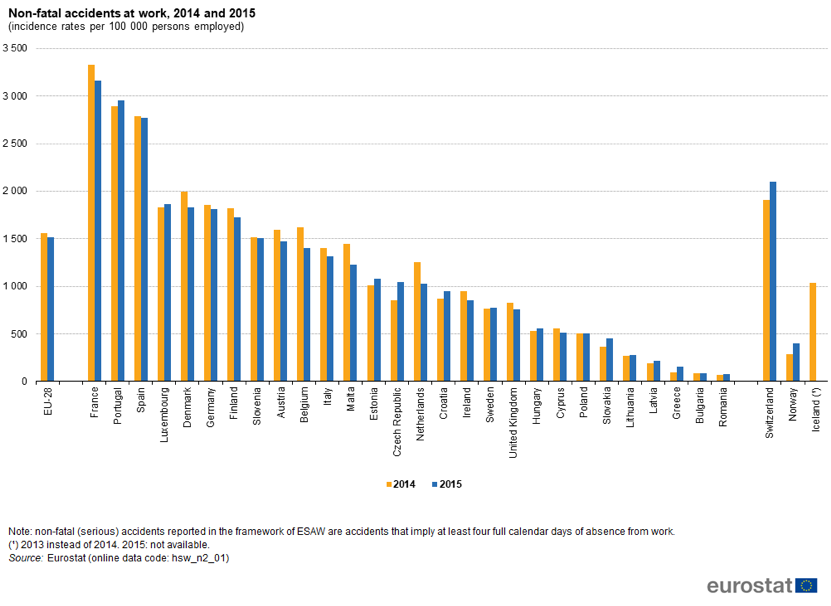
Table 2
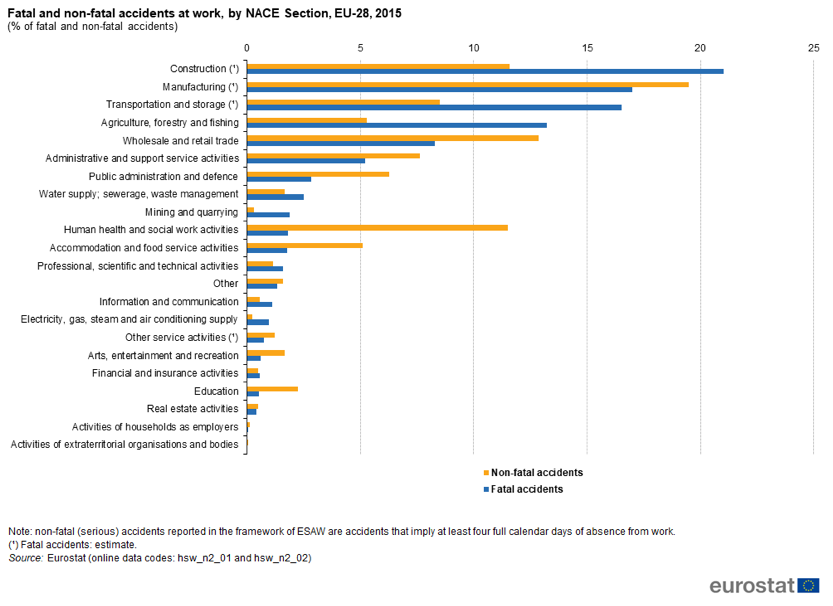
Table 3
As shown in the previous tables, it is easy to see that the level of standardised incident rates of all countries in the EU-28 reflects a high number of accidents, fatal and non-fatal ones, in all the EU, and Spain is the 11th country in fatal accidents and the 3th one in non-fatal accidents. Seeing the table 3, where the accidents are represented by sectors in all EU countries the importance of the construction sector is remarkable due to accidents registered.
Looking at the data in the table 5 which reflects the incidence rates by autonomous communities within the Spanish state, we can assure that the trend has been similar in the last ten years in all of them, reflecting a decrease in the incidence rate of accidents in the construction sector during the years of economic crisis but since 2013 it is appreciate how the upward trend of accidents has returned. And within all the regions, the data reflects that the Balearic Islands is the region with the highest incidence rate.
SOURCE: Ministerio de Trabajo, Migraciones y Seguridad Social. Anuario de Estadísticas Laborales. Disponible en: http://www.mitramiss.gob.es/es/estadisticas/contenidos/anuario.htm
Occupational accident incidence rates with sick leave by sector of activity (years 2007-2017).

Table 4 (number of accidents per 100.000 workers)
Occupational accident incidence rates with sick leave in Construction sector (years 2007-2017).
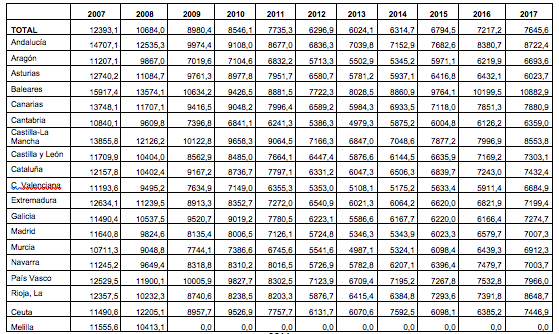
Table 5
Incidence rate (IR) of accidents in the construction sector in the Balearic Islands 2013-2016
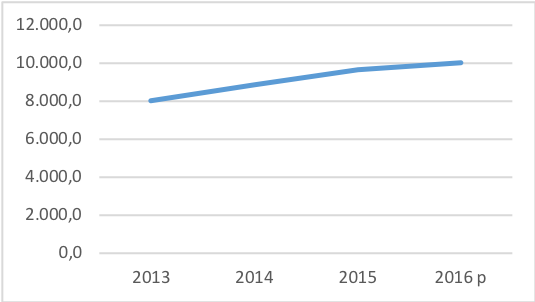
INSHT. Observatorio de Condiciones de Trabajo.
Table 6
With these data, for the similar characteristics, it is reasonable to think that the values studied can be extrapolated to any other region in Europe.
1.1 Literature review and hypotheses statement
There is a lot of literature that remarks the importance of the safety training usually mixed with others items. And not only the training before starting work, but the necessary continuous training to guarantee a good result. It should be noted, that “a vital factor of a successful safety program is to periodically train and educate all employees to enhance their knowledge and skill about safety at work. For new employees, safety orientation is necessary to inform them about safety goals“ (Bavafa, Mahdiyar, & Marsono, 2018) pointing as literary references among others (Cheng, Lin, & Leu, 2010), (Fernández-Muñiz, Montes-Peón, & Vázquez-Ordás, 2007) (Tam, Zeng, & Deng, 2004)(Hallowell, Hinze, Baud, & Wehle, 2013).
Another example is the Thesis where, Carvajal proposed a five-step cycle, and education and training, are in these important steps, pointing that it is necessary taking into account more variables when making the final analysis. In the same line, we found (SUÁREZ SÁNCHEZ, CARVAJAL PELÁEZ, & CATALÁ ALÍS, 2017)
They mean that training and education reflects the impact that the former steps have upon the people involved if some improvement needs to take place, and the importance that it could have in the final results.
(Jeschke et al., 2017) found in their study that changing the training program focusing in some items detected to avoid the most common accidents was successfully.
With these premises we want to propose two hypotheses for the development of our study:
H1. High levels of safety training before start the works have a positive effect on accidents rates of a company.
At the end of the study we intend to verify if there is a direct relationship between the previous and currently mandatory training in Spain that workers of a contractor must have in order to work in the construction sector and the accident levels of these companies. And in the case of finding a direct relationship if it is negative as previously thought.
A higher investment has a positive effect on firm accident rate and economic-financial results.
Studying the economic effects of accidents in companies there is a lot of literature. In this study and taking advantage of the economic data that we have of the companies, we intend to investigate if as we have established in the previous hypothesis if the companies invest in a greater training in safety and health of their workers, they have fewer accidents, and if it were the case if the cost of these has a greater or lesser effect on the economic results of these companies.
1.2 Study and classification of compulsory training
The training established by the collective agreement for the construction sector is divided into several levels. On the one hand, the current minimum level is the first cycle of eight hours, with basic concepts plus training equivalent to the "Second cycle of training in occupational risk prevention in the construction sector: training by job or by trades "that will have a minimum duration of 20 hours and whose content is fixed by the agreement itself. This training can be of 6 hours when there are circumstances such as that a module of 20 hours has already been carried out or that the worker has previously completed the basic level training mentioned for the construction sector.
The workers who must exercise as a preventive resource in the work are required, as a minimum, the basic level of prevention in construction, whose training content is specified in the agreement and will have a minimum duration of 60 hours.
Therefore, in our study we have divided the training of the workers of the companies in these three levels, according to data provided by the Fundación Laboral de la Construcción (FLC).
2. Methodology
2.1 Procedure
Once the compulsory training has been analysed, different variables have been created to be able to make a good analysis of the data.
On the one hand, the training variables and on the other, the economic variables, as they are found in the table 7.

In the table 7 we exposed all the variables we have created in this study, where:
Training variables:
Form_total - Amount of hours of training that the company has given to all their workers duing 2017.
Form_basic - Amount of hours of basic training provided by the company to their workers.(20h per worker)
Form_mixed - Amount of hours of basic plus specific training provided by the company to their workers. (60h per worker)
Form_specif - Amount of hours of official specific job training provided by the company to their workers. (6h per worker)
Form-rate - Total amount of hours of any training (form_total) divided by number of workers of the company.
Economic variables:
N_empl - Number of workers of the company
Roa & roa-1 - Return on assets of the company in the year and the year before.
asseturn & assetum-1 - Assets of the company in the year and the year before.
solvencyratio & solvencyratio-1 - Solvency ratio (used to measure the ability of a company to meet its long term debts), in the year and the year before.
ownresource_emp & ownresource_emp-1 - Own sources of the company per worker, in the year of the study and the year before.
ulcr & ulcr-1 - Labor cost per worker in the year and the year before.
Accidents variables:
Num_acc - Number of accidents with sick leave suffered by the company's employees during 2017
Acc_rate - Number of accidents with sick leave suffered by the company's employees divided by number of workers of the company during 2017
Of all these variables, our explanatory variable are training variables and the others, economic ones, we have introduced as company control variables.
We collected information about different companies and procedure crossing different databases, obtained through the signing of agreements with public and private entities. These are the Fundación Laboral de la Construcción (FLC), which has all the data of the training that they give directly or their approved companies and the Conselleria de Treball of the Govern of Balearic Islands, who has all the data of the accidents that have occurred in the sector and classified by company and its severity.
The training database is currently the most limited, since it only gives the information of one year, 2017. It will be a limitation of our study, that in the future we expect to widen the data until minimum ten years to be able to increase our knowledge of the real situation.
2.2 Sample
There are 5.609 construction companies registered in Balearic Islands according to the data received from IBESTAT[i]. We start the study with the database of all the companies that figures at SABI[ii], in order to have the economic information to use it at our study. In SABI database were 3.549 companies of the total mentioned, it represents the 63,27%.
We crossed the result of companies of Sabi with the training of 2017 and the accidents databases. Of the total of the companies in the construction sector in the region, some worker of 1656 companies suffered some type of accident with loss. And of these, 728 companies are in Sabi's first database. Thus, the final sample is of 728 companies of the construction sector in the Balearic Islands.
2.3 Development process
Once the databases were crossed, and proceeded to create the aforementioned variables in order to make a matrix with companies, training, accidents data.
Thus the process of analysis of each variable was started by using the STATA program.
Then the correlation matrix was created to see the dependence between our variables in order not to distort the results of the study. After the analysis, as appreciate in table 8, where the correlation matrix is shown, the labour cost variable (ulcr) and the solvency ratio variable (solvencyratio) were eliminated due to their correlation with the others variables. Labor cost is correlationed with form_rate and solvencyrate with ownresources_emp.
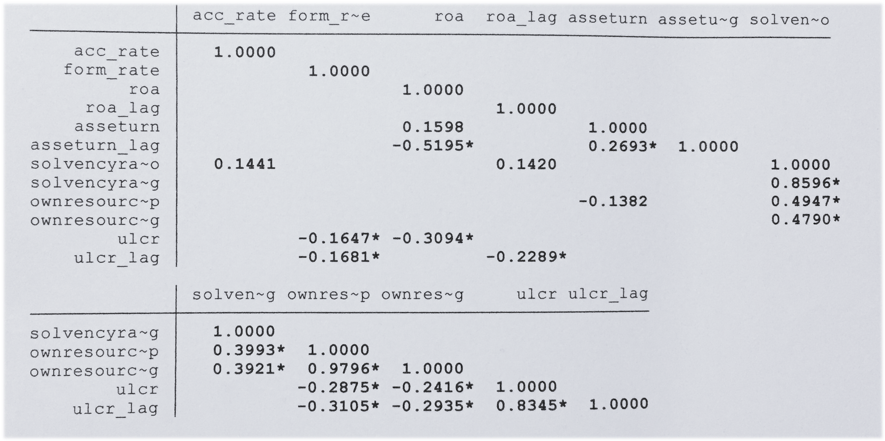
When analysing the data it was verified that the most of the observations of accident rate was concentrated between 0 and 0.9, as reflected in the graphic nº1, thus being able to focus the study in such cases. In order to carry out the study of companies in which at least one of their employees had an accident with sick leave, the data of the companies that had not suffered an accident was removed, that is, the observation in the variable num_acc was 0.
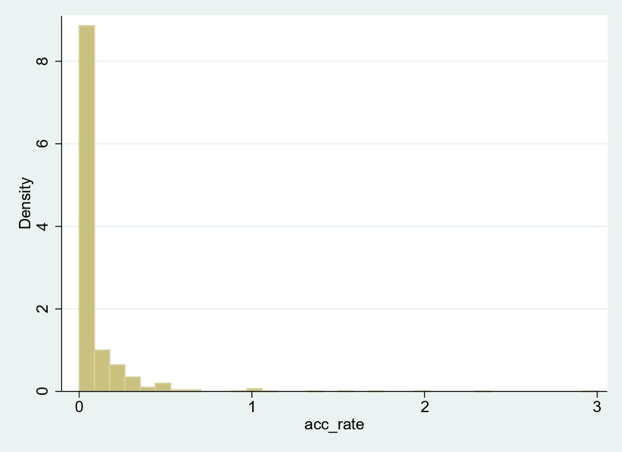
Graphic 1
Once the variables created were validated and the data analysed with STATA, a regression of the observations that complied with the given requirements was carried out, and after having eliminated the companies in which no worker had suffered any accident, 670 observations remained.
3.Results
Table was made to report the information we have collected using SABI database (ROA, asseturn and ownresource by worker) and Labour Authority records (number of accidents, accident Incidence Rate).
The result of the regression of the data performed as can be seen in table 9, shows that there is a negative and significant relationship between training ratio and accident rate of a company. That is to say, the greater the training of workers by a company, the lower its accident rate.
The negative ratio of accident ratio and own resources per employee is also significant. That is to say, the greater the investment of the company in own resources per employee, the accident rate is reduced.
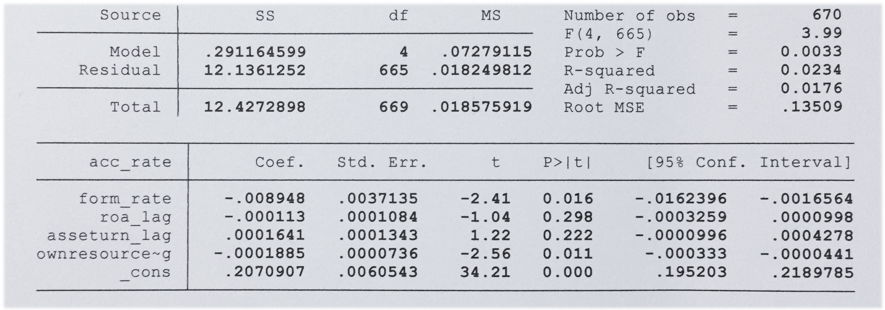
With these data the two hypotheses can be solved.
H1. High levels of safety training before start the works have a positive effect on accidents rates of a company.
As can be seen in table 10 of the results, there is a negative and significant relationship between the training that a company gives to its employees and its accident rate. Therefore, the hypothesis is not null, but it can be seen that the higher ratio of training of workers in the company, the lower accident ratio.
H2. A higher investment have a positive effect on firm accident rate and economic-financial results.
As can be seen in the results obtained, there is a direct, negative and significant relationship between the own resources that a company allocates per employee and its accident results. So, hypothesis two can be confirmed in that a higher investment of own resources per employee lower accident rate. Regarding our study, the variables of roa and assets are not significant.
4. Discussion and conclusions
The main objective of this paper is to analyse the relationship between training and accidents in a representative sample of companies in the construction sector, where we know that is a very important problem.
After analysing all the training, accident and economic data of the companies in the study, the importance is highlighted not only of the necessary training and obligation that every company must provide its employees, but also continuous training. As well as highlighting that the investment a company makes for each of its employees, both in training and in necessary means in safety and health revert positively in the company with better results lowering the accident rate and consequently the cost thereof.
5. Limitations and future challenges
There are some limitations to considering and the principal one is the complication to have real and sufficient data of workers, accidents and companies. The construction sector is very closed when it comes to analyse the necessary data. But it opens a future challenge, is important not to leave this way and be able to complete this study with a panel data of a minimum of ten years. (2007-2017). In that way we will be able to make a better study and extract more and better conclusions of the relationship between safety training and accidents.
4. Discussion and conclusions
The main objective of this paper is to analyse the relationship between training and accidents in a representative sample of companies in the construction sector, where we know that is a very important problem.
After analysing all the training, accident and economic data of the companies in the study, the importance is highlighted not only of the necessary training and obligation that every company must provide its employees, but also continuous training. As well as highlighting that the investment a company makes for each of its employees, both in training and in necessary means in safety and health revert positively in the company with better results lowering the accident rate and consequently the cost thereof.
5. Limitations and future challenges
There are some limitations to considering and the principal one is the complication to have real and sufficient data of workers, accidents and companies. The construction sector is very closed when it comes to analyse the necessary data. But it opens a future challenge, is important not to leave this way and be able to complete this study with a panel data of a minimum of ten years. (2007-2017). In that way we will be able to make a better study and extract more and better conclusions of the relationship between safety training and accidents.
[1] IBESTAT: Institut d'Estadística de les Illes Balears
[1] SABI: Iberian Balance Sheet Analysis System. Database that contains financial information of Spanish companies.
Bavafa, A., Mahdiyar, A., & Marsono, A. K. (2018). Identifying and assessing the critical factors for effective implementation of safety programs in construction projects. Safety Science, 106(June 2017), 47–56. https://doi.org/10.1016/j.ssci.2018.02.025
Carvajal GI (2008) Modelo de cuantificación de riesgos laborales en la construcción: RIES-CO. (Tesis Doctoral). Valencia, España: Universidad Politécnica de Valencia; 365 p.)
Cheng, C. W., Lin, C. C., & Leu, S. S. (2010). Use of association rules to explore cause-effect relationships in occupational accidents in the Taiwan construction industry. Safety Science, 48(4), 436–444. https://doi.org/10.1016/j.ssci.2009.12.005
Fernández-Muñiz, B., Montes-Peón, J. M., & Vázquez-Ordás, C. J. (2007). Safety management system: Development and validation of a multidimensional scale. Journal of Loss Prevention in the Process Industries, 20(1), 52–68. https://doi.org/10.1016/j.jlp.2006.10.002
Hallowell, M. R., Hinze, J. W., Baud, K. C., & Wehle, A. (2013). Proactive Construction Safety Control: Measuring, Monitoring, and Responding to Safety Leading Indicators. Journal of Construction Engineering and Management, 139(10), 04013010. https://doi.org/10.1061/(ASCE)CO.1943-7862.0000730
Jeschke, K. C., Kines, P., Rasmussen, L., Andersen, L. P. S., Dyreborg, J., Ajslev, J., … Andersen, L. L. (2017). Process evaluation of a Toolbox-training program for construction foremen in Denmark. Safety Science, 94, 152–160. https://doi.org/10.1016/j.ssci.2017.01.010
SUÁREZ SÁNCHEZ, F. A., CARVAJAL PELÁEZ, G. I., & CATALÁ ALÍS, J. (2017). Occupational safety and health in construction: a review of applications and trends. INDUSTRIAL HEALTHIndustrial Health, 55(3), 210–218. https://doi.org/10.2486/indhealth.2016-0108
Tam, C. M., Zeng, S. X., & Deng, Z. M. (2004). Identifying elements of poor construction safety management in China. Safety Science, 42(7), 569–586. https://doi.org/10.1016/j.ssci.2003.09.001


